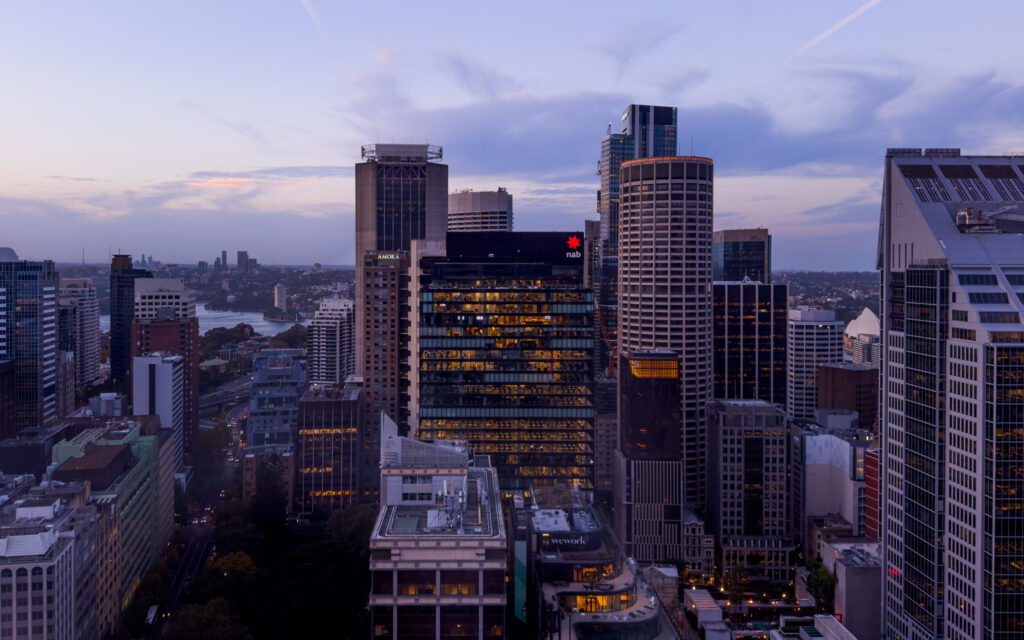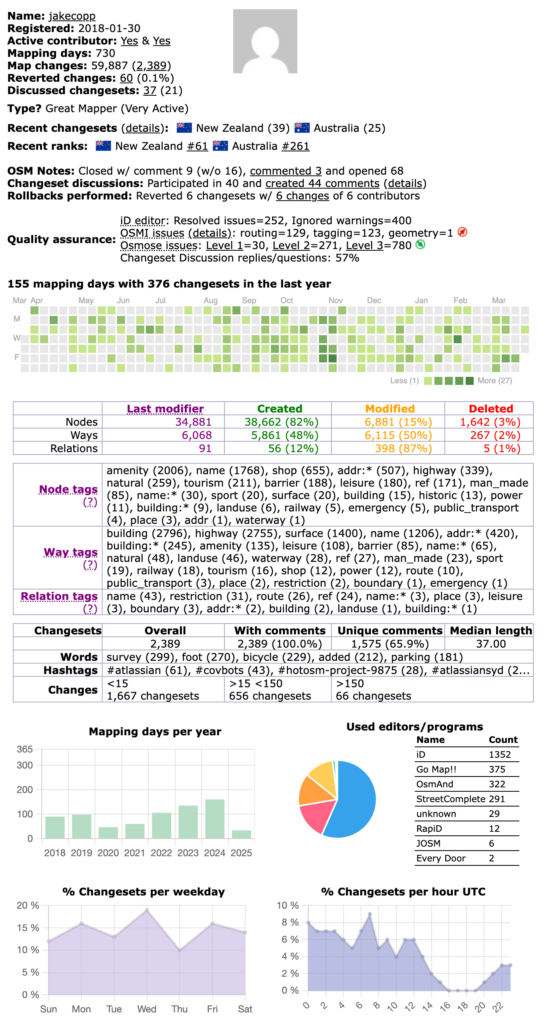
After 5 years, I’m leaving Atlassian to take a gap year; and by gap year I mean a little travel, and a lot of time to explore hobbies, side-projects, and consulting in the space between software and urbanism.
Atlassian is a pretty special place to work. However as my friends have the unfortunate burden (and in my coffee fuelled opinion the excitement!) of hearing out, I’m burning up with ideas, and haven’t had the full capacity to triage, research, and execute on them. For every blog post I’ve written (see a wrap of my side-projects below), there’s 5 to 10 others I haven’t had the chance to explore. For the projects I do dig into, there’s been a limit to the scale of what I can build.
I’m currently working on a commercial collaboration contract looking at quantifying walkability (with fascinating improvements on anything I’ve seen done before) which I’m excited to showcase in the coming months.
If you have an interesting challenge in the urban analysis, community consultation, or planning space in the coming year that could use a software solution – and are looking for an ex-Atlassian full stack software engineer to scope and build it – get in touch. If you’re interested in hearing about solutions I build looking for problems to solve – before they’re ready to write about – also get in touch!
Otherwise, you’ll still catch me in the violin section of the Strathfield Symphony Orchestra, working with Better Streets and WalkSydney, in the waves, on my bike and of course – in a coffee shop writing plenty more here for you, dear reader!
Table of contents
The last 5 years at Atlassian
I’ll detail my technical achievements on my resume page, but I wanted to add a few other notes.
Not taking a gap year in 2020 was a brilliant idea in hindsight! I was fortunate to intern in 2018 under employee #40 and join full-time in 2020 after completing a degree and several internships. Beyond the perks it’s publicly known for (alongside Australian FAANG outposts) it’s been especially interesting to work at Atlassian – a leading tech company building collaboration products – through the transition from in person collaboration in 2020 to remote by default (and staying the course).
As a company that builds collaboration and project management products there’s a particular focus on dogfooding ways of working – so much so that some of these excellent resources are publicly exported in research backed exercises.
I’ve learned so much about building high quality software (at scale) from so many incredibly talented engineers, product managers and designers and I’d happily return there in the future.
The last 5 years of side projects
What else have I worked on in the last five years?
I finished a four-year project looking at the before and after impact of the new Sydney CBD light rail. I photographed the opening day of the new Drying Green park in the City of Sydney – an infill development of Green Square (and captured detailed 3D models) – along with the Sydney CBD swimming hole at Marrinawi Cove in Barangaroo.
I captured the moon touching the Opera House on a 600mm lens and the Metabolist masterpiece where the Kyoto Protocol was signed (which received almost a quarter million views).
I visited and mapped every single QMS advertising panel in the City of Sydney (leading to further analysis by Canva & ex. Google engineer Max Bo). I built tools for finding COVID vaccines during the acute shortage in mid-2021 which directly lead to 5,809 HotDoc booking referrals.
I visualised bus congestion utilising Marey charts – a cult favourite data visualisation technique – which are still niche enough my analysis is the 3rd Google result on the subject (spawning further writing on the technique). I’ve met proud urban planning consultants raise their 1983 Tufte book cover to the room when discussing it! I captured and shared takeaways from Australia’s first micro-mobility conference.
In an evergreen blog post that continues to receive mountains of traffic, I shared my technique of creating aerial imagery using commodity bike helmet cameras and OpenDroneMap, with significant interest from Mapillary (Meta) and inspiring future work by international geospatial engineers. I followed this up with utilising the LiDAR sensor in your iPhone to achieve similar results, using this in the vertical dimension to capture a never before seen slice of the beautiful escalator arrangement of Town Hall Station.
I dove deep into cycling advocacy. While I’m not aware of any impact, I’m extremely proud of my work documenting Canada Bay Council ripping out a cycleway paid for by taxpayers of NSW (likely, considering my audience, your money), rationalised by a dodgy engineering report the council later removed from their website. I went real deep – scouring the Internet Archive, spilling over 3000 words of digital ink dissecting the report that included analysis of point cloud data I constructed.
I utilised the rich bicycle data specification of OpenStreetMap (OSM) to programatically identify candidate streets for bicycle contraflow signage installation in inner Sydney, and continue to survey bicycle contraflow signage on OSM as the council implements it. Looking to gain an birds-eye-view of how bicycle riders experience infrastructure around Australia and the world, I generated detailed reporting of cycleway infrastructure for every council in Australia compared with worldwide examples (I was later told queries I wrote for this project were utilised for a commercial economic analysis report).
I compared the best bicycle routing apps (which use OSM, of course). I built upon fascinating work by speculative cartographer Dustin Carlino, writing a vector tileserver (from scratch in one afternoon) utilising JS bindings for the Rust osm2streets code (compiled to Wasm) to visualise per-lane street detail – which as Justin O’Beirne captured in April 2022, Google had not done so for any Australian city yet.
I began my long descent into the minutiae of traffic signal design and politics looking at how Sydney traffic signal operations adjusted during COVID. I became transfixed the more I learned and constructed a crowdsourced campaign to map experienced pedestrian delays by building Better Intersections – first in Sydney and now around the world. This project ripped across LinkedIn, became the subject of an ABC News article and has been linked from the Sydney Morning Herald.
A month later, I wrote a detailed explainer for a general reading audience (Shining a Light on the Traffic Signals of Sydney) looking at the complex design, policy and politics of Sydney traffic signals and how they are so important to our urban experience. This analysis started waves with traffic engineers, was shared as a “must read” in the Committee for Sydney newsletter in July 2023, and I continue to update the page as more practitioners share history and context. The open data my project collected enabled me to write an initial analysis with beautiful Observable Plot graphs, and highlight the insanity of a Sydney Metro trip taking less time between stations than crossing the road next to the entrance (sharing a side-by-side comparison video with my 61k YouTube subscribers).
Other projects didn’t make it into a blog post. I built basic tooling for improving the Signal to Matrix chat bridging experience (long before Signal was this cool!). I started a Matrix to ChatGPT Bot, which a contributor took over and grew into a userbase with 241 Github stars and over 220 PRs. I built an event planning app (with P3 colour space typography!) in the nascent days of Partiful (and long before Apple Invites) with bridged two-way Matrix RSVP integration. I built a basic dashboard with Observable.js charts of the UNSW Research Centre of Integrated Transport Innovation (rCITI) walking and cycling count data so it could be released publicly. I built tooling (at extremely short notice) to drive advocacy submissions at the Better Streets talk hosting Lee Waters, Clover Moore and Rob Stokes, generating templated email submissions for a user’s local council members in a low friction form. I wrote a basic council transcript generator and fzf-powered fuzzy search engine to keep track of what’s going on. And really early on, I built a simple Lambda transformer for TfNSW bus data for my Pebble smartwatch app (I’ve got a rePebble on order!).
With Better Streets, I wrote a detailed submission for the North Bondi Shops and Bus Terminus Upgrade, supporting change however compositing LiDAR scans and project docs in Blender to highlight flaws in the design (while referencing unimplemented best practice policies). I led the drafting and was the primary contributor for an even more detailed submission on the shocking TfNSW plans to add more lanes to Epping Bridge – while the project’s own engineering reports show an increase in vehicle traffic and that any travel time benefit to evaporate within decades.
I turned my eyes to the infamous Sydney Park Junction project, unpacking secret design changes announced in private, by omission, barely a month before shovels-in-the-ground after 7 years of planning. This blog post (which was the first the public learned of this issue), was later followed by two Sydney Morning Herald articles. Even after the Minister for Transport intervened due to community pressure, I found the project scope still wasn’t guaranteed, and by researching newly discovered documentation and writing up a detailed timeline I supported others uncovering extremely concerning allegations.
After some of this work I was nominated for the Committee for Sydney Young Sydneysider of the Year Award in June 2024 – I still don’t know who by!
All of the above were published as open source code or open data – and I contributed to OpenStreetMap some ~60,000 map changes over ~2.3k changesets since 2018.
I worked on these projects in my leisure time, on top of full time work at Atlassian (where I received a promotion in 2022), along with the usual things a twenty-something gets up to in Sydney!
I’m looking forward to seeing what I can get up to with an extra 8 hours a day.

Leave a Reply